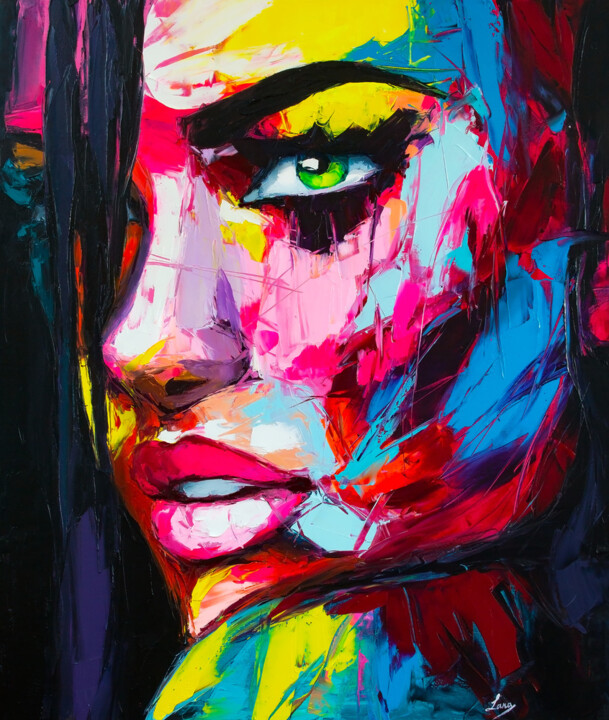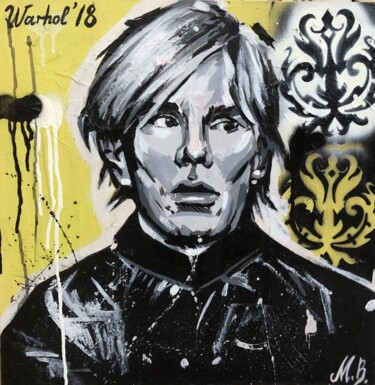 Eugen Dick, Portrait 75, 2022. Acrylic on canvas, 120 x 120 cm.
Eugen Dick, Portrait 75, 2022. Acrylic on canvas, 120 x 120 cm.
 Bazévian Delacapucinière, Portrait PS118 Into the night, 2021. Oil / acrylic / spray / ink on canvas, 100 x 81 cm.
Bazévian Delacapucinière, Portrait PS118 Into the night, 2021. Oil / acrylic / spray / ink on canvas, 100 x 81 cm.
Pop self-portraits: Warhol, Hamilton and Yayoi Kusama
In order to narrate how Pop art has interpreted the portrait, a genre of remote origins, dating back even to ancient Egypt, it is possible to refer to the work of three iconic masters of the movement, namely Andy Warhol, Richard Hamilton and Yayoi Kusama. In particular, they also ventured into the description of their own person, experimenting with self-portraiture, a figurative phenomenon, which, although it has been established since the medieval period, achieved artistic dignity only in the Renaissance. Wanting to propose a comparison of exemplars of the latter type of artistic investigation, by the above-mentioned, it seems indispensable to mention, in the first place, the Pop master par excellence, namely Andy Warhol, who, on more than one occasion tried his hand at performing self-portraits. The American devoted himself to the latter artistic phenomenon starting in 1964, when, with the work Self Portrait, he transformed the genre into a colorful depiction, which, full of deep contrasts, pursued the intention of capturing, both the beauty, and the fame of the artist, qualities notoriously attributable to the most well-known celebrities he esteemed. At the same time, however, Warhol saw the self-portrait, and the portrait in general, as a colorful medium, often treated with fading effects, aimed at alluding to even more serious meanings, such as death, since even myths could not be spared from the latter's incumbency. Describing the 1964 masterpiece, the work replays the repetition of images taken from a series of photos, which the artist took of himself in the booth of a shopping mall the year before, inside which he was captured wearing sunglasses, a raincoat and an unmistakable stance of a star, intended to take shape within a blue background. Warhol's same figurative seriality is found in Hamilton's Four Self-Portraits 05.3.81, a 1990 work that repurposes a shot from the 1980s in which the artist immortalized himself using his Polaroid camera. That image, in the masterpiece in question, was embellished by the application of acrylic paints, becoming an enlarged print, intended to represent the layering of the master's creative process, as well as his approach to different artistic media. A similar process applies to another self-portrait by Hamilton, namely Self-portrait with Yellow (1998), which, synthesized into a single image, reproduces the aforementioned union of pictorial and photographic art. Finally, the last "term of comparison" artist is the very popular Yayoi Kusama and, in particular, her 2010 Self-portrait, which, sold by Christie's in 2019, stands out for the vibrancy of its orange hues, effectively concentrated in the effigy's thick hair. In reality, however, if one looks more closely at that subject, one can clearly discern a base of green paint, which, laid before the fluorescent hues, gives volume to the curls. "The Queen of Polka Dots," however, could not neglect the quintessential symbol of her work, so that she has covered the surface of her skin with beige, yellow and orange dots, details that turn into an explicit statement of artistic identity. Other details are richly arranged on the surfaces and background, generating an extremely vivid, chromatically rich, as well as highly distinctive and unusual pictorial plane. In addition, the artist has also taken great care to generate chromatic recalls, which are realized in the orange tones of the hair, lips and skin, and, at the same time, in the purple tones of the eyes, eyebrows and dress. Finally, it is important to make known how, within the Japanese woman's artistic investigation, the self-portraits mark a turning point, capable of showing the connection between the artist's identity, her condition, and her creative point of view.
 Lana Frey, Hope, 2021. Oil on canvas, 130 x 110 cm.
Lana Frey, Hope, 2021. Oil on canvas, 130 x 110 cm.
 Iryna Kastsova, Katy Perry, 2021. Acrylic on canvas, 100 x 100 cm.
Iryna Kastsova, Katy Perry, 2021. Acrylic on canvas, 100 x 100 cm.
Pop portraits: the story continues with Artmajeur artists ...
In addition to the aforementioned self-portraits, portraits of the aforementioned genre also turn out to be very popular in the history of art, as well as in the contemporary world, in which, now accustomed to the language of advertising, we are, to say the least, addicted to high-impact color images, enriched with messages and allusions similar to those of the world of television, film, the Internet and social media. In fact, briefly tracing the history of Pop art, it was born right at the end of the 1940s, a period when the consumerist mentality was spreading, as a "positivist" response to the dramas of World War II, which were "reconverted" into a compulsive, superficial and seemingly joyful desire to live, achievable precisely through production, consumption and communication. The modern context, with its many dramas, fits perfectly into the above mentality, which has even been enriched, and made much more complex, by the new strategies of production, dissemination and consumption of goods. The Pop portraits of Artmajeur artists, such as, for example, those of Olivia Caballero González, Laurence Uzan, and Alexander S Peuchot, find their place in this extremely current context.
 Olivia Caballero González, Bi-sensual, 2022. Oil on canvas, 100 x 81 cm.
Olivia Caballero González, Bi-sensual, 2022. Oil on canvas, 100 x 81 cm.
Olivia Caballero González: Bi-sensual
The frontal framing of an intriguing, hypnotic and, at the same time, veiledly ironic subject brings us back to the language of advertisements, for which the protagonist of the work seems to be an eccentric testimonial. Nevertheless, we are very wrong if we think that "frivolous" Pop art has never taken a more "serious" stance, for, on some particular occasions, this has happened. In fact, Caballero's "masculine" woman could also be the bearer of a more complex feminist message, revealing its full affinity with an iconic, and, at the same time provocative, masterpiece such as Evelyne Axell's Ice Cream (1964). It was precisely the latter painting that gave voice to the ideals of the Belgian artist, who, at the time, explicitly advocated a progressive liberalization of female sexuality through the medium of art. This message was realized on canvas through the depiction of a monochromatic female face, caught in the moment when she is intent on sensually licking a colorful ice cream cone, positioned against an equally chromatically rich and vibrant background. The image just described, having clear sexual connotations, pursues the intent to oppose the idea, that women should be shamed for their sexuality, so that, in a similar vein, the Artmajeur artist's work could remind us, that there is no weaker sex.
 Laurence Uzan, Lips, 1997. Acrylic on canvas, 30 x 30 cm.
Laurence Uzan, Lips, 1997. Acrylic on canvas, 30 x 30 cm.
Laurence Uzan: Lips
The narrative of art history is so rich, that it is highly likely to encounter in the present the "remembrances" of what was. However, what has been said must be interpreted positively, as contemporary works represent a kind of cultural stratification, where, among the recurrences, one can also find explicit evolutions of humankind. In this context, it seems evident, and somewhat obvious, how the characteristics of Pop art, highly akin, both to twentieth-century consumerism, and to the modern one, recur in the figurative investigation of our times, well exemplified by Uzan's painting Lips. It is precisely this latter work that presents a strong iconographic link with the tradition of the aforementioned movement, in that it is particularly akin, albeit in an entirely unique and original way, to one of the most iconic subjects of the artistic investigation of Tom Wesselmann, an American painter, sculptor and artist. In detail, this "similarity" relates to the aforementioned painting by the artist from Artmajeur and the series of lips made by the American master, protagonists of a particular context of creative experimentation. In fact, in the early 1960s, Wesselmann made some monumental paintings, which, depicting nudes of blondes in languid atmospheres, evolved, little by little, into the creation of individual details of the female body, such as the mouth, breasts and feet. Therefore, taking into account this historical precedent, we could interpret Uzan's work as a portrait, which, deliberately "reduced to the minimum," summarized the expressiveness of a female face through the depiction of an intense close-up of her provocative lips.
 Alexander S Peuchot, Janet, 2021. Acrylic / oil / pigments / spray on canvas, 121.9 x 91.4 cm.
Alexander S Peuchot, Janet, 2021. Acrylic / oil / pigments / spray on canvas, 121.9 x 91.4 cm.
Alexander S Peuchot: Janet
Referring to Warhol's iconic Pop example, from the twentieth century onward the protagonists of show business became the subjects of artistic investigation; in fact, the American master himself also portrayed stars from the world of music, such as Elvis Presley, Dolly Parton, Mick Jagger and Debbie Harry. Such work was the result of the fascination exerted by fame and popular culture on the artist, whose concept of repetition of the subjects depicted alluded precisely to the loss of identity inherent in mass consumer culture itself. The works resulting from this conception of reality were made from tabloid photographs or advertising shots, which Warhol transformed into colorful silkscreens. The same approach to art can be seen in the work Janet, a painting aimed at repurposing the iconic Rolling Stones cover, which, dated 1993, immortalized the eponymous singer wearing only baggy jeans and her breasts covered by the hands of her ex-husband Rene Elizondo. That image, which has indelibly become part of the Pop lexicon, alludes to the concepts made explicit by the album of the same year, namely Janet, aimed at representing a provocative exploration of female pleasure and sexuality, acquired by a now more mature and independent woman who had achieved greater confidence with sex, understood also as a joyful part of the creative process.


 Olimpia Gaia Martinelli
Olimpia Gaia Martinelli























